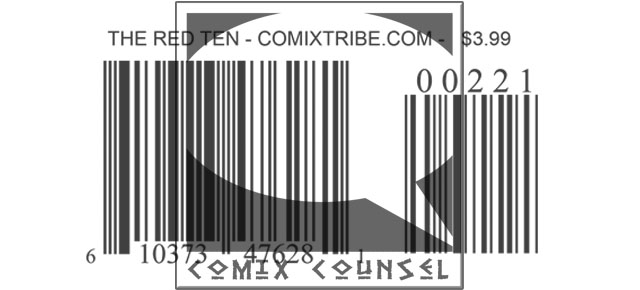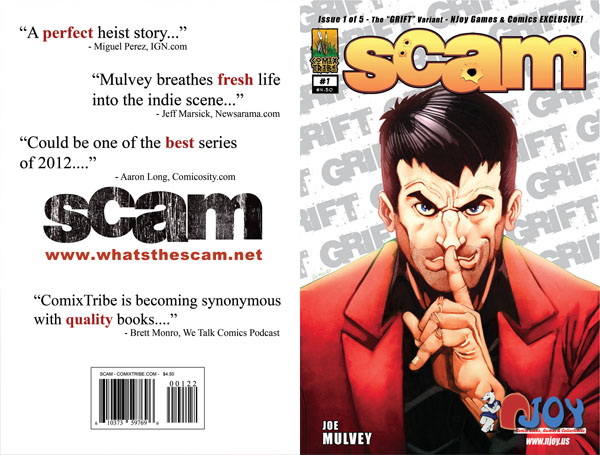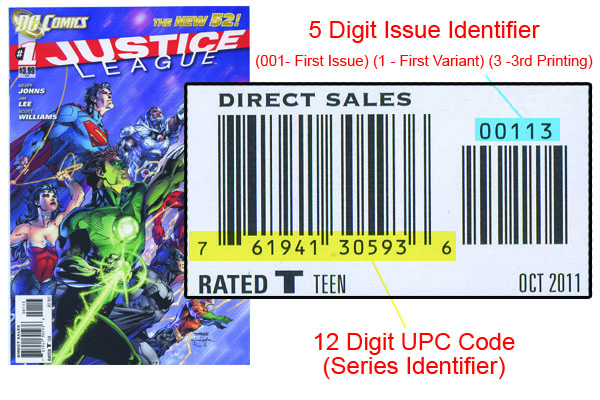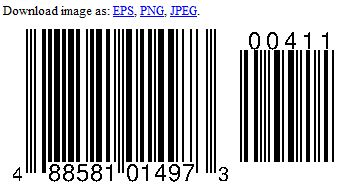UPDATED! Barcodes, ISBNs, UPCs, Oh My!
UPDATE! (7-10-2013) – Surprisingly enough, this little column is one of the most read, most linked to posts on ComixTribe.com…clearly lots of small-press creators bump up against the Barcode demons eventually, and so some clear answers to common questions are desired. Since this article was first posted, I’ve learned a few more things, so I’ve updated this column with them. Enjoy!
Settle in, kiddies, ’cause it’s about to get BOR-ING up in here!
Today’s topic is barcodes, namely putting them on your comics. Not a sexy topic in the least, but one that you might find yourself stressing out over in the near future if you’re doing the DIY distribution thing. If that’s not you, come on back next week, and I promise to write about something juicier. But if I don’t write this and archive it, I might find myself struggling to remember this stuff the next time I’m prepping books.
Disclaimer: I may be wrong on some of this stuff. While I have put all of this advice into practice to print and distribute more than 40,000 comics and graphic novels to date, I am NOT an expert, so do your due diligence. You can’t believe everything you read on the internets.
Do I Need a Barcode for My Self-Published Work?
Maybe not.
It really depends on where you’re selling your books. If your only means of distribution is selling direct to consumers online through your website and at conventions, the answer is no. I’ve never once had a reader at a con look for or comment on a book’s lack of a bar code.
But what about if you want to get your book into retailers? Well, again, the answer is no, you don’t NEED one. We sold 777 copies of SCAM #1 direct to retailers in January 2012, and they bought the books, put them on their racks, and they sold to customers just fine. (Maximum Comics sold 100 copies day one, in fact!)
However, many retailers, especially the large ones, really prefer to sell books that have barcodes. As John Robinson from Graham Cracker Comics (nine stores in Illinois) told me, “Barcodes make it A LOT easier to track sales.” This makes a LOT of sense. Many retailers pay good money for sophisticated electronic sales tracking systems. No barcodes mean those systems don’t work nearly as good. If Graham Cracker doesn’t know how well ComixTribe books are selling, when it comes time to re-order, chances are they’re going to order on the light-side. So lack of barcodes on your books could be costing you sales.
And if you want to go through Diamond Distribution, barcodes are an absolute requirement.
Do I Need an ISBN?
Okay, you want to sell through retailers, so you’ve decided you need a barcode? But what kind? You can play around with free barcode generators all day long, as there are many different kinds of codes and such out there. And what’s the deal with ISBNs? Do I need to get one of those?
Short answer: Graphic Novels need ISBNs, Floppies/Serials do not.
ISBNs can be purchased from Bowker, and they are expensive. Definitely purchase in bulk (probably 10), because when it’s all said and done, the cost of 10 is close to the cost of 1. (Get one for $125, 10 for $250.) More on ISBNs from the website:
ISBNs are linked to essential information allowing book-sellers, and readers, to know what book they are buying, what the book is about, and who the author is.
- ISBNs are the global standard for identifying titles ISBNs are used world-wide as a unique identifier for books. They are used to simplify distribution and purchase of books throughout the global supply chain.
- Most retailers require ISBNs to track book inventory Without an ISBN, you will not be found in most book stores, either online or down the street from your house. Buying an ISBN is your first step to insure that your book is not lost in the wilderness.
- Buying an ISBN improves the chances your book will be found Buying your ISBNs and registering your titles on My Identifiers, insures information about your book will be stored in our Books In Print database. This opens up a world of possibilities that your book is listed with many retailers, libraries, Bowker Books In Print, Bookwire, as well as online services like Google Books, Apple’s iBooks, Chegg and the New York Times.
So, yes, you want an ISBN for your Graphic Novel (again only necessary if you want to sell through retail channels, Amazon, etc.) Once you have an ISBN, you can either purchase a barcode with it, or use one of the free barcode generators. (I prefer free…because, well, I’ve got other things to spend money on.)
What About Floppies? You Down With UPCs, Yeah You Know Me!
Okay, so what about the floppy. For these, you’re going to want a UPC code.
UPC Defined: The Universal Product Code (UPC) is a barcode symbology (i.e., a specific type of barcode), that is widely used in North America, and in countries including the UK, Australia, and New Zealand for tracking trade items in stores. Its most common form, the UPC-A, consists of 12 numerical digits, which are uniquely assigned to each trade item.
UPCs can be purchased from a number of sites online. Here’s one that I’ve used and found the service pretty solid. Once again, the more you buy, the cheaper they are, but it’s not as ridiculous a discount as with ISBNs. One thing that’s cool about this service is they automatically generate the barcode with the UPC on it for you.
The Good News: Each SERIES only needs ONE UPC code. So, for example THE RED TEN is a 10 issue mini-series. I can buy one UPC code ($9.99) and use it for the entire series.
But, how then, do you tell one book from another, if they all have the same UPC? Glad you asked.
Can I Get Your Digits?
Each floppy series has a 5-digit extension code that identifies the issue number, the cover variant, and the printing number.
For example:
A Five Digit Number of 00111 means:
001(issue number) 1(what cover variant) 1(what printing)
Pretty simple, right?
So, for the NJoy Games & Comics variant of SCAM #1 second printing, it’s identifier is going to need to be: 00122. First Issue (001), second variant (2), second printing (2).
Got it?
How to Generate a Barcode for Your Comics (FREE)
I’m told there is special software you can buy to generate your barcodes, but FREE is usually, better, correct. So, to generate a FREE barcode for your comic:
1) Go to the free barcode generator I mentioned earlier.
2) Set the “Symbology” parameter to: UPC – A
3) Enter your twelve-digit UPC code, followed by a space, and then your 5 digit UPC identifier code.
4) Click MAKE BARCODE which will generate a snazzy barcode like this:
5) Click Download image as EPS to get a file I can bring into Photoshop and slap on my book.
And there you go. You now have a street legal UPC code ready for retailers, ready for Diamond. All that’s left is to deface your pretty comic with it!
Barcode Placement
The last thing to figure out in this process is where exactly to put your barcode. Luckily, most comic creators are also comic fans, and have hundreds or thousands of comics lying around…most of them with barcodes. So, the easiest thing to do is just copy what your favorite series does, in terms of barcode placement.
Now, Diamond requires your barcode to be placed on either the front or back cover. (Putting the barcode on the inside of the book will get them sent back to you, with a hefty infraction charge sent your way.)
For our direct market books SCAM, THE RED TEN, and THE STANDARD, we’ve opted to place our barcodes on the back cover of our books. Basically, our covers are too damn pretty to defile with barcodes…at least that’s the thinking.
However, I have heard feedback from retailers and serious collectors, that they prefer it when publishers put barcodes on the FRONT cover of books. Why? Well, some retailers bag and board books for customers, and most serious collectors do as well. The board covers up the back cover, making back cover barcodes no longer visible, so to ring it through the cash register the cashier has to open up the bagged and boarded comic just to scan it. That adds time and effort to the point of sale, and increases the chance of the book getting damaged before leaving the store. This was something I never thought of, but seems reasonable. Given this, and the fact that most big pubs put barcodes on the front of their books, is enough to make me reconsider their placement for our next wave of books.
And there you have it! At least, I’m pretty sure that’s all there is too it. Oh, the things you find yourself struggling to learn on the road to creating comics. It really is amazing.
Experts, correct me if I’m wrong about anything, or if you have a cheaper, easier way to handle the bar code business. I’m all ears.
WAS THIS ARTICLE HELPFUL? IF SO, PLEASE TAKE A MOMENT TO SHARE IT:
“If you #makecomics this @tylerjamescomic article on Barcodes is a must read!” (Click to Tweet)
Keep Reading!
If you found this article useful, you may want to read one of these three articles next:
Tips for Submitting to Diamond
Proofing a Book
Digital Pricing Dilemmas
Related Posts:
Category: Comix Counsel






















Hey Tyler,
Great information as always. Do you think QR codes have any important role to play in self-publishing?
Good question, Nick. I read an article on Tech-Crunch the other day suggesting that QR Codes perhaps have already reached the height of popularity and will start to fade soon, as they haven’t quite been adopted as an incredibly useful tool.
QR’s won’t replace barcodes anytime soon.
That said, I did put a QR Code on the ComixTribe banner I had printed up for conventions last year, and on ComixTribe one page ads that run on the back covers of books. But I have not really set up a tracking mechanism to determine what kind of return I’m getting from that.
My gut tells me it’s still a novelty…something that can’t hurt, but certainly won’t make or break your self publishing future.
Still, I’ll be keeping my eye out for folks who are using QR Codes or any new technologies in innovative ways.
Great information, thank you so much.
Glad to help, Wolf!
Great stuff, Tyler! I’ve been curious about this myself and you just drastically sped up my learning curve. Thank you!
Happy to help, Sean! Good luck navigating those waters!
Even though this article is almost a year old now, I wanted to say thank you Tyler. I wanted to know how UPC codes applied to comics and why some books had them and others didn’t. This posting clarified all of that, including why comics had a barcode of length 17 instead of length 12. You also gave a great and detailed explanation why usually only graphic novels get the ISBN treatment.
This was VERY information and I’ll most definitely be bookmarking this webpage! Thanks!
Happy to help, Devin!
Hey Tyler! Thanks for the info; just to follow up- did you ever have trouble with the barcodes you had to piece together? I did they work just fine out in the wild?
No problems reported so far.
as a courtesy to collectors and retailers could you please put barcodes on the front cover instead of the back cover… you see when comics are bagged and boarded the back cover is no longer visible,so to ring it through the cash register the cashier has to open up the bagged and boarded comic just to scan it. which is a hassle,now combine a cashier hurrying and tape on the flap of the bag and there’s a good chance of it getting stuck to the cover and damaging the comic before it even leaves the store. either that or retailers have to copy your barcode to a label and stick it to the outside of the bag.
alot of software for comic collectors allow you to scan the barcodes to enter comics into your database,which again means opening up the bagged and boarded comic.
barcodes don’t have to be a boring black and white rectangle you throw onto the bottom corner.as long as the background is a light solid colour and the lines are a dark solid colour with high contrast between the two colours it will still scan so you can integrate it into the art work it self. here’s a few examples to get you thinking outside the box
http://www.darkroastedblend.com/2008/04/japanese-creative-barcodes.html
Hey Tyler! Really appreciate this article as I’m taking this step for the first time currently. I had a couple of related questions regarding placing the UPC barcode in terms of Size and image DPI possible coming into play.
I used the generator tool above but the size of the barcode is very large and much more so than those I see on most comics and not very friendly to my double splash cover artwork just placed on the comic “as is”.
If you decide to expand the article, this could be a good area to delve into a bit more. Please let me know if you have any tips! Thanks again for the info!
Now cover ISSN, please.
Can use the same UPC for 2 different printing companies, on the first print run? Because I want to do a test/promo run for diamond and local shops. And if I get picked up by diamond I want to print a mass abundance of the same #1 issue still claiming it a first print using the same UPC and print number. In this case would that still be considered a first print #1.
Bat, can you? Certainly. Your printer isn’t going to check to make sure that it is the first printing. They’re going to print whatever files you send them. It’s up to you though, whether or not you want to release something that isn’t a first printing and call it a first printing.
But what if I need to test print something for diamond and they pick it up and I decide to go to a different printer, a cheaper printer so I can print more.
I don’t think anyone is going to ding you on that.
Creators also do sample/test/ not for retail distribution printings that don’t have barcodes on them.
thank you, tyler! If we make a collected graphic novel out of the series, is that also part of the same UPC or ISBN as the floppies? (with a different extension number?)
John,
ISBNs are different than UPCs.
USPs are for individual comics.
ISBNs are for book with spines (trades, hardcovers, etc.)
So, you’ll get one UPC for your individual comic series, and with each issue, update the 5-digit number on the end.
Then, when you bring to trade, you’ll get an ISBN, which will allow you to sell your trade at places like Amazon and bookstores.
Hope that helps!
Also, if you’re printing soon, definitely check out this podcast episode I recorded with the KrakenPrint crew. So much good stuff there –>
034 – Comics & Graphic Novel Printing 101 with Jacob and Sam from KrakenPrint
http://www.comixlaunch.com/session034/
Golden! Thank you Tyler, we’re listening to the podcast right now!
P.S. is the bonus checklist cheat-sheet still available? can’t seem to find comicslaunch.com/printchecklist… thanks 2 million!
oh, found it: it’s “comix” not “comics”… sorry!
Hi, don’t know if this will get seen, but just a question. Does the UPC standard remain for Australian creators? You might not know, but I can’t find an answer anywhere for the right kind to use for distribution here. Thanks!
Haydn, yes, this is the standard you want to use IF you’d like to get into Australian shops going through Diamond Comic Distributors. However, I do not know what conventions are for other distribution channels. If you’re trying to sell directly to shops in Australia, some might not require UPCs at all.
Thanks for the response!
Hello Tyler, I just wanted to say thank you so very much! My partner, Darrell Smith, and I just started a new comic book company (Square Biz Comics) this article was so amazingly helpful to us. We look forward to reading more from you in the future!
Just checking in all these years later to ask if all is still well with the UPCs from the company you recommended in the article? Do you still use them?
Absolutely! Of course, it’s probably been a year or two since I’ve purchased UPCs from them, because I usually buy in bulk!